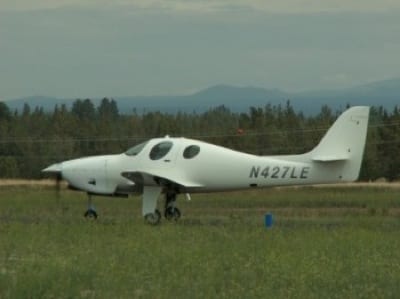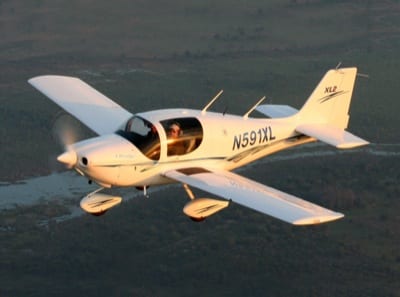Every year at Oshkosh, companies unveil their latest and greatest innovations.
This year was no exception, with engine manufacturers taking center stage, from the largest companies to those just breaking into the market. Fuel efficiency and the ability to adapt to alternative fuels were all touted by manufacturers at the big show.
Among the latest developments unveiled at AirVenture:
LYCOMING
On opening day of Oshkosh, Lycoming officials announced that the iE2, the company’s integrated electronic propulsion system, had flown to the show from Redmond, Ore., on a Lancair Evolution.
 “Thus begins a new era for piston-powered aviation in general and Lycoming Engines in particular,” said Ian Walsh, Lycoming’s senior vice president and general manager at the time (He has since been promoted to Chief Innovation Officer at Textron, Lycoming’s parent company, replaced by Michael Kraft.)
“Thus begins a new era for piston-powered aviation in general and Lycoming Engines in particular,” said Ian Walsh, Lycoming’s senior vice president and general manager at the time (He has since been promoted to Chief Innovation Officer at Textron, Lycoming’s parent company, replaced by Michael Kraft.)
“The promise of single-lever operation, automated preflight safety checks and automotive start simplicity will dramatically reduce pilot workload and revolutionize the general aviation landscape,” Walsh said, adding, “the iE2 system will increase fuel efficiency, reliability, and make alternative fuel consumption possible without major hardware changes, protecting the customer’s investment. We believe it points to a bright future for piston-powered general aviation.”
He noted baseline iE2 system testing is complete, the first OEM installations are being calibrated and the certification program is underway.
The iE2’s maiden flight on an OEM airframe occurred July 2 when Lancair flew its TEO-540-EXP iE2-powered Evolution. After initial flight testing, the aircraft was flown east to Oshkosh on its way to Lycoming’s base in Williamsport, Pa., where it will undergo further flight testing.
The 350-hp twin-turbocharged TEO-540-A1A is the first iE2 engine model planned for FAA certification. Prior to certification, an experimental version will be available as an option for experimental aircraft.
Oshkosh also marked the debut of the first IO-233-LSA light sport engine installation. T&T Aviation of Washington, Pa., displayed its Falcon LSA at the Lycoming exhibit. After Oshkosh, on-wing ground, taxi and flight testing with the IO-233-LSA began. The engine is designed to run on gasoline, with multiple continuous power ratings as high as 116 hp.
Lycoming expects to start shipping non-certified IO-233s in the fourth quarter of 2009. Engine certification is slated for the first quarter of 2010.
Testing also continues in Lycoming’s unleaded automotive gasoline program for its O-360 and IO-360 engines. The intended fuel is the unleaded 93 AKI automotive gasoline, which conforms to either Euro Norm EN228 or ASTM D4814.
Work also continues on Lycoming’s partnership with the FAA and Swift Enterprises to research the use of 100SF, a renewable fuel being developed by Swift Enterprises of West Lafayette, Ind., as a possible replacement for 100LL aviation fuel. The company’s goal is to develop a renewable fuel to replace 100LL without requiring modifications to existing engines.
Lycoming is providing the engines for the testing of the fuel, while the FAA’s Aviation Fuel and Engine Test Facility is performing the testing.
For more information: Lycoming.com.
TELEDYNE CONTINENTAL MOTORS
Preparing for alternative fuels also is a top priority at Teledyne Continental Motors, Inc. (TCM).
Officials at the Mobile, Ala.-based company flew the company’s turbocharged SR22 (pictured below) to Oshkosh using UL94 unleaded aviation fuel.
While ASTM actively works on certification of the new fuel, TCM has shifted from testing the fuel to preparing its engines for its eventual introduction.
“(The) flight demonstrated that our standard factory turbo is ready for future fuels,” said Rhett Ross, president. “With successful flights of both turbocharged and normally aspirated engines on unleaded fuels, we feel comfortable that TCM has solutions for the future and are now working to have them ready.”
In March, TCM began testing the fuel in a Bonanza. Those tests were followed in April by a flight fueled by Swift Fuel.
Meanwhile, TCM’s turbocharged SR22, which the company has dubbed the TR22 (Turbo Realized 22), has spawned a new STC program.
“Our initial intent was to use our TR22 as a technology demonstrator for our Kinetic engine line and alternative fuels,” said Ross. “But we quickly realized that we were on to something that was too good not to offer to current Cirrus SR22 owners looking for a performance upgrade.”
The STC should be available by the end of the year.
TCM also revealed at Oshkosh that it had received FAA certification on the first Full Authority Digital Electronic Controlled (FADEC) turbocharged engine.
The company developed the Turbo FADEC 550 in response to requests from airframe manufacturers wanting a high horsepower engine with advanced electronic engine controls, according to Ross.
The engine boasts a rating of 350 hp at 2,600 rpm. TCM’s PowerLink FADEC reduces pilot workload to selecting a desired power setting using a single lever. Once the pilot selects the power, the system automatically manages fuel to either “Best Power” or “Best Economy,” depending on the pilot’s preference. As demonstrated in recent test flights, the system ensures ease of operation and automatic adjustment of fuel flow to maintain fuel economy and engine operating parameters without constant pilot involvement, TCM officials note.
An experimental version of the new engine has been flying on a Lancair IVP for over 550 hours, enabling the plane to achieve economy cruise speeds of 255 kts., while enjoying a 17.5 gal/hr fuel burn.
For more information: GenuineContinental.aero.
DIAMOND AUSTRO ENGINE
The FAA recently certified Diamond Aircraft’s Austro Engine AE300.
The jet-fuel burning, 170-hp turbo-diesel piston engine offers single lever thrust control, electronic engine management and monitoring, Diamond officials said.
The engine was developed by Austro Engine in collaboration with MB Technology GmbH (Mercedes Benz) and Bosch General Aviation Technology GmbH, after the bankruptcy of Thielert, which provided the engines for many of the Diamond fleet.
Diamond officials note the new engine features the “very latest in high pressure common rail fuel injection technology, offering even better fuel consumption than the first generation turbo-diesel engines originally used by Diamond.”
FAA certification of the AE300 paves the way for certification of the DA42 NG. That certification is expected in the third quarter of this year.
For more information: DiamondAircraft.com.
LIBERTY AIRCRAFT
Liberty Aerospace, Inc. unveiled the first XL2 fitted with the Wilksch Turbo Diesel at Oshkosh.
The two-seat plane, which burns Jet A fuel, is designed to appeal to the international marketplace where 100LL is both expensive and hard to obtain, according to officials with the Melbourne, Fla.-based company.
 “Our international customers have been very clear to us,” said Keith Markley, president and CEO. “They need an alternative fuel to 100LL for aircraft they are running in their flight training fleets.”
“Our international customers have been very clear to us,” said Keith Markley, president and CEO. “They need an alternative fuel to 100LL for aircraft they are running in their flight training fleets.”
Wilksch Airmotive, formed in 1994 in the UK, is developing the engine, which uses a two-stroke “diesel” operating cycle. The two-stroke cycle allows high power outputs without the need for a reduction drive, according to company officials, who noted the technology has little in common with conventional two-stroke engines, as there are no roller bearings and no crank-case compression or oil-fuel mixing. The engines achieve a power/weight that matches or betters traditional avgas burning four-stroke engines, officials said.
For more information: Wilksch.com or LibertyAircraft.com.
GE HONDA AERO ENGINES
Engine assembly has begun on the GE Honda Aero Engines’ first HF120 engine for FAA certification testing.
The HF120, launched in 2006, was selected to power the HondaJet and the Spectrum Aeronautical Freedom business jet.
HF120 engine production will initially begin at GE’s site in Lynn, Mass., and will later transition to Honda Aero Inc.’s recently completed engine production and overhaul facility in Burlington, N.C.
For more information: GEHonda.com, Honda.com or GE.com.
DELTAHAWK
DeltaHawk Engines, Inc. and LoPresti Speed Merchants have begun work on an STC to install a DeltaHawk Turbo-Diesel engine in a Cirrus SR20.
The SR20 will be the first aircraft certified with the DeltaHawk engine.
The Jet-A-fueled DeltaHawk Turbo-Diesel engine has the highest power-to-weight ratio of any aero-diesel engine, according to company officials, who note it burns 30%-40% less fuel on a typical mission than a gasoline engine, and develops 100% of rated horsepower to 18,000 feet.
When matched with the SR20 airframe, the package will offer higher payload and greatly enhanced range and speed, DeltaHawk officials note.
LoPresti Speed Merchants is working on a cowl to increase aerodynamic performance.
“The DeltaHawk-LoPresti collaboration is leading the way to the future of general aviation,” said Diane Doers, DeltaHawk CEO. “The performance and value of the SR20 aircraft is going to be greatly enhanced — and this is just the first of many STCs that will be coming.”
For more information: DeltaHawkEngines.com or SpeedMerchants.com.
Look for more on engines, including offerings from SMA, Flight Design, Mistral and others, in future posts.
